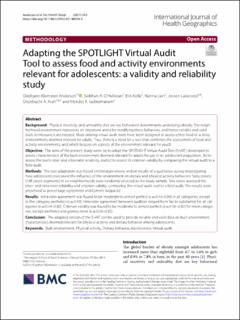| dc.contributor.author | Andersen, Oddbjørn Klomsten | |
| dc.contributor.author | O'Halloran, Siobhan Anne | |
| dc.contributor.author | Kolle, Elin | |
| dc.contributor.author | Lien, Nanna | |
| dc.contributor.author | Lakerveld, Jeroen | |
| dc.contributor.author | Arah, Onyebuchi A. | |
| dc.contributor.author | Gebremariam, Mekdes Kebede | |
| dc.date.accessioned | 2021-12-08T11:43:57Z | |
| dc.date.available | 2021-12-08T11:43:57Z | |
| dc.date.created | 2021-05-07T11:16:43Z | |
| dc.date.issued | 2021 | |
| dc.identifier.citation | International Journal of Health Geographics. 2021, 20(2021), Artikkel 4. | en_US |
| dc.identifier.issn | 1476-072X | |
| dc.identifier.uri | https://hdl.handle.net/11250/2833342 | |
| dc.description | This article is licensed under a Creative Commons Attribution 4.0 International License, which permits use, sharing, adaptation, distribution and reproduction in any medium or format, as long as you give appropriate credit to the original author(s) and the source, provide a link to the Creative Commons licence, and indicate if changes were made. The images or other third party material in this article are included in the article’s Creative Commons licence, unless indicated otherwise in a credit line to the material. If material is not included in the article’s Creative Commons licence and your intended use is not permitted by statutory regulation or exceeds the permitted use, you will need to obtain permission directly from the copyright holder. | en_US |
| dc.description.abstract | Background: Physical inactivity and unhealthy diet are key behavioral determinants underlying obesity. The neighborhood environment represents an important arena for modifying these behaviors, and hence reliable and valid tools to measure it are needed. Most existing virtual audit tools have been designed to assess either food or activity environments deemed relevant for adults. Thus, there is a need for a tool that combines the assessment of food and activity environments, and which focuses on aspects of the environment relevant for youth.
Objective: The aims of the present study were: (a) to adapt the SPOTLIGHT Virtual Audit Tool (S-VAT) developed to assess characteristics of the built environment deemed relevant for adults for use in an adolescent population, (b) to assess the tool’s inter- and intra-rater reliability, and (c) to assess its criterion validity by comparing the virtual audit to a field audit.
Methods: The tool adaptation was based on literature review and on results of a qualitative survey investigating how adolescents perceived the influence of the environment on dietary and physical activity behaviors. Sixty streets (148 street segments) in six neighborhoods were randomly selected as the study sample. Two raters assessed the inter- and intra-rater reliability and criterion validity, comparing the virtual audit tool to a field audit. The results were presented as percentage agreement and Cohen’s kappa (κ).
Results: Intra-rater agreement was found to be moderate to almost perfect (κ = 0.44–0.96) in all categories, except in the category aesthetics (κ = 0.40). Inter-rater agreement between auditors ranged from fair to substantial for all categories (κ = 0.24–0.80). Criterion validity was found to be moderate to almost perfect (κ = 0.56–0.82) for most categories, except aesthetics and grocery stores (κ = 0.26–0.35).
Conclusion: The adapted version of the S-VAT can be used to provide reliable and valid data on built environment characteristics deemed relevant for physical activity and dietary behavior among adolescents. | en_US |
| dc.language.iso | eng | en_US |
| dc.subject | adolescence | en_US |
| dc.subject | built environment | en_US |
| dc.subject | dietary behavior | en_US |
| dc.subject | physical activity | en_US |
| dc.subject | virtual audit | en_US |
| dc.title | Adapting the SPOTLIGHT Virtual Audit Tool to assess food and activity environments relevant for adolescents: A validity and reliability study | en_US |
| dc.type | Peer reviewed | en_US |
| dc.type | Journal article | en_US |
| dc.description.version | publishedVersion | en_US |
| dc.rights.holder | © The Author(s) 2021 | en_US |
| dc.source.pagenumber | 14 | en_US |
| dc.source.volume | 20 | en_US |
| dc.source.journal | International Journal of Health Geographics | en_US |
| dc.identifier.doi | 10.1186/s12942-021-00258-0 | |
| dc.identifier.cristin | 1908713 | |
| dc.description.localcode | Institutt for idrettsmedisinske fag / Department of Sports Medicine | en_US |
| dc.source.articlenumber | 4 | en_US |
| cristin.ispublished | true | |
| cristin.fulltext | original | |
| cristin.qualitycode | 1 | |
